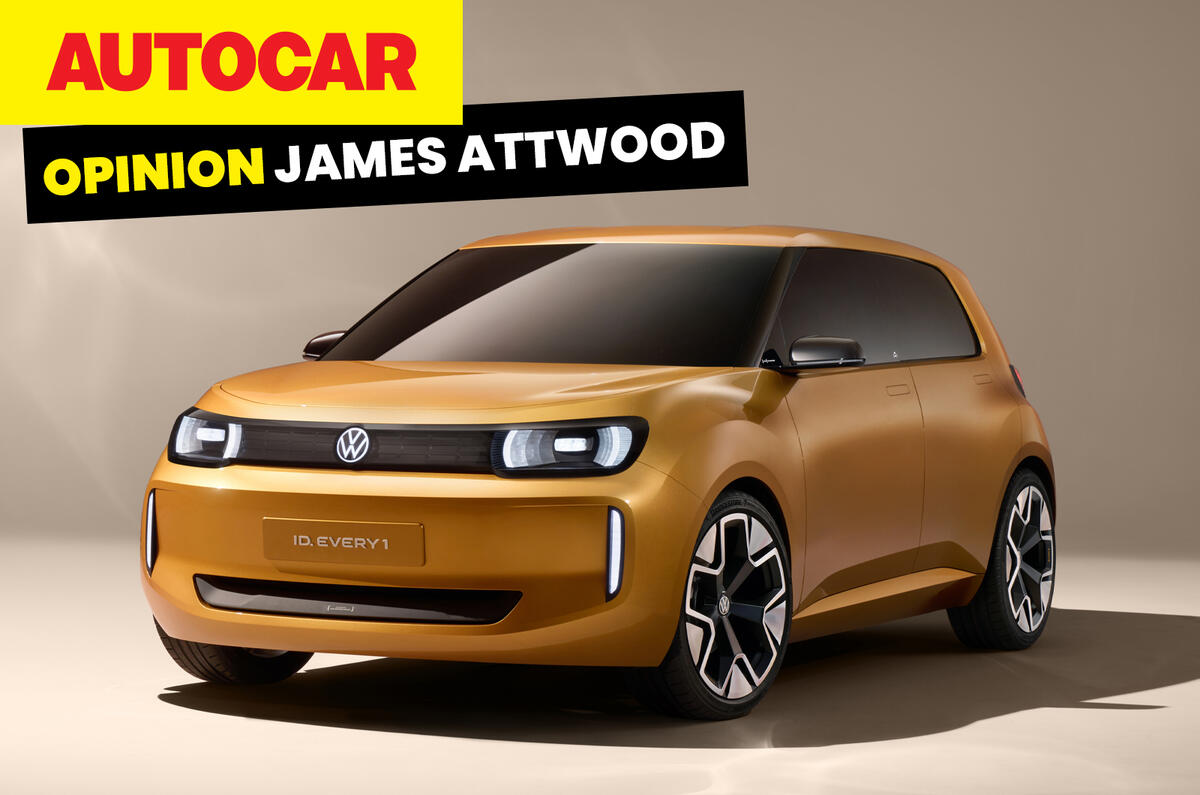There’s a lot to like about the Volkswagen ID 1. In an age when cars are forever growing bigger, here’s a proper city car that's right-sized and looks great.
A mainstream car brand committing to the A-segment is something to celebrate.
But there’s one big concern: with a promised range of “at least” 155 miles, it’s possible the ID 1 will go on sale in 2027 with basically the same range as offered by later versions of its spiritual predecessor, the e-Up. That doesn’t feel like progress.
To be fair, the ID 1 promises to be larger, more practical, more powerful and around £3000 cheaper than a new e-Up would have set you back in 2023 (and the e-Up benefitted from a government grant). Those are hard-won gains, and they haven’t been easy. Still, it’s a stark illustration of how making affordable electric cars is a huge challenge.
EV batteries are slowly – glacially – getting cheaper, but they remain by far the most expensive part of a new EV.
Volkswagen was determined to hit its €20,000 (£17,000) target for the ID 1, and the best way to do that is to right-size the battery for its intended urban use case.
Trouble is, that requires buyers to accept a potentially unpalatable compromise. A range of 155 miles might be fine for the everyday, but what about those occasional weekend trips away?
History suggests buyers are unlikely to compromise with their main or only car.
It’s concerning that, like the Renault Zoe, Nissan Leaf and e-Up in the early days of mass-market EVs a decade or so back, the likes of the ID 1 and Dacia Spring could find most success as budget second cars – a daily runaround that allows you to keep your bigger, posher car for the weekend.
Which is great, but that means instead of widening access to electric mobility, the new wave of cheap EV is really providing further benefit to more affluent buyers who can afford two cars. Single-car owners on a budget who don’t want to compromise will stick with petrol.










Join the debate
Add your comment
This is exactly the kind of EV the government should have encouraged at the start and (if they really had to) direct the subsidies here.
Why is it a problem if it's second cars? My parents had 2 cars for the past 4 decades - they are decidedly working class. Very common to have 1 big and one smaller car in a household.
If they'd encouraged these, we'd have fewer issues with range anxiety for local travel, fewer issues as most early adopters could 100% home charge as the wider infrastructure caught up, they'd clean up air in towns on those 1-2 mile trips where ICE cars are the most polluting.
A couple of generations of these with the first proper long range cars arriving now as 2nd or 3rd generation EVs with better range and faster charging.
Battery costs are ‘glacially’ getting lower? They dropped by 90% from 2008-2023! ($1415 per kw/h down to $139 per kw/h).
This being the case, 155 miles is now then enough if you can charge at home. way more than the average UK daily trip.
I see them everywhere and have friends that use their Ups for long journey's all the time. Until now getting a small car often meant compromising on space, equipment, performance and refinement, but never the freedom to travel wherever you want. But small EVs are now forcing that compromise. I understand the issues over battery cost and weight in a small car, and hopefully there will be larger battery options. But invariably they'll be more expensive, whereas a base ICE city car will travel just as far as the top of the range model. As battery tech improves, this will become less of an issue but we're not there yet.
Maybe you live in a bubble where Ups are everywhere.
Also, in what reality a city car car drive as far as a tip of the range model, on a single tank? Same is with the electric ones: take a break after 150 miles.
Yes, but people worry about charging their vehicle when they stop. Fine if you're on a motorway (if expensive), not so much if you are visiting friends and family, going to the beach, etc.
The reality is that folks buy the most capable car they can afford, and this is why the Honda e and Mazda MX30 - both very likeable cars - have flopped.
Sticking with the Up! as an example, they all have 35 litre tanks. So whether you chose the base or top spec model they'll all have a similar range. With an EV, you'll have to pay extra for more range. Plus, if the EV does 155 miles, take 20% off in winter and you're left with 124 miles. But most people don't run their cars to 'empty' so realistically you've got no more than 100 miles usuable range and that's when new, not after a few years when inevitably the battery has lost a little capacity. For a second car that's fine, but as your only car, I'm not so sure.
Exactly - and you can use 33+ of that 35 litres - 330-350miles of actual range, rain or shine.
I've done 200-250 mile non-stop drives in tiny cars (we had a Citroen C1 as our only car for a while). We are used to that length of trip so do it in 1 go.
Our Corsa-e claims about 210 miles. Need to charge it after 110-120 on the motorway in mild weather, and that's at 60-65 mph. Stopping for 30+ mins whilst the journey is already 45-60 minutes longer due to lower cruise speeds is painful when it's Friday evening and you just want to get there.
Having said that, a city car that can do 150, at that price (half the Honda e/Mazda) should be a success as long as it's sold as a car for <100 mile round trips or city use.